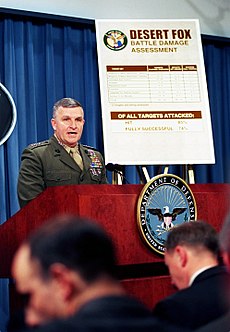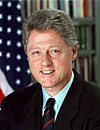
Iraq actively researched and later employed weapons of mass destruction (WMD) from 1962 to 1991, when it destroyed its chemical weapons stockpile and halted its biological and nuclear weapon programs as required by the United Nations Security Council. The fifth president of Iraq, Saddam Hussein, was internationally condemned for his use of chemical weapons against Iranian and Kurdish civilians during the Iran–Iraq War in the 1980s. Saddam pursued an extensive biological weapons program and a nuclear weapons program, though no nuclear bomb was built. After the Gulf War, the United Nations located and destroyed large quantities of Iraqi chemical weapons and related equipment and materials; Iraq ceased its chemical, biological and nuclear programs.
United Nations Special Commission (UNSCOM) was an inspection regime created by the United Nations to ensure Iraq's compliance with policies concerning Iraqi production and use of weapons of mass destruction after the Gulf War. Between 1991 and 1997 its director was Rolf Ekéus; from 1997 to 1999 its director was Richard Butler.

The United States-led invasion of the Republic of Iraq was the first stage of the Iraq War. The invasion began on 19 March 2003 and lasted just over one month, including 26 days of major combat operations, in which a combined force of troops from the United States, the United Kingdom, Australia and Poland invaded Iraq. Twenty-two days after the first day of the invasion, the capital city of Baghdad was captured by coalition forces on 9 April after the six-day-long Battle of Baghdad. This early stage of the war formally ended on 1 May when U.S. President George W. Bush declared the "end of major combat operations" in his Mission Accomplished speech, after which the Coalition Provisional Authority (CPA) was established as the first of several successive transitional governments leading up to the first Iraqi parliamentary election in January 2005. U.S. military forces later remained in Iraq until the withdrawal in 2011.

The Iraqi no-fly zones conflict was a low-level conflict in the two no-fly zones (NFZs) in Iraq that were proclaimed by the United States, United Kingdom, and France after the Gulf War of 1991. The United States stated that the NFZs were intended to protect the ethnic Kurdish minority in northern Iraq and Shiite Muslims in the south. Iraqi aircraft were forbidden from flying inside the zones. The policy was enforced by the United States and the United Kingdom until 2003, when it was rendered obsolete by the 2003 invasion of Iraq. French aircraft patrols also participated until France withdrew in 1996.
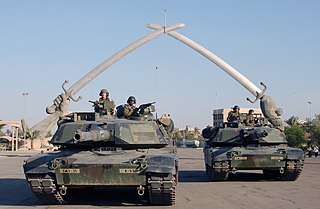
The following is a timeline of major events during the Iraq War, following the 2003 invasion of Iraq.

The Iraq Survey Group (ISG) was a fact-finding mission sent by the multinational force in Iraq to find the weapons of mass destruction alleged to be possessed by Iraq that had been the main ostensible reason for the invasion in 2003. Its final report, Comprehensive Report of the Special Advisor to the Director of Central Intelligence on Iraq WMD, was submitted to Congress and the president in 2004. It consisted of a 1,400-member international team organized by the Pentagon and Central Intelligence Agency to hunt for the alleged stockpiles of weapons of mass destruction, including chemical and biological agents, and any supporting research programs and infrastructure that could be used to develop WMD. The report acknowledged that only small stockpiles of chemical WMDs were found, the numbers being inadequate to pose a militarily significant threat.

David A. Kay was an American weapons expert, political commentator, and senior fellow at the Potomac Institute for Policy Studies. He was best known for his time as United Nations Chief Weapons Inspector following the first Gulf War and for leading the Iraq Survey Group's search for weapons of mass destruction following the 2003 invasion of Iraq. Upon presentation of the Group's finding that there had been significant errors in pre-war intelligence concerning Iraq's weapons programs, Kay resigned. The ensuing controversy served as impetus for the formation of the Iraq Intelligence Commission.
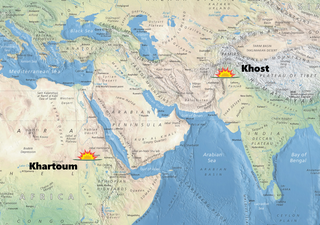
Operation Infinite Reach was the codename for American cruise missile strikes on al-Qaeda bases that were launched concurrently across two continents on 20 August 1998. Launched by the U.S. Navy, the strikes hit the al-Shifa pharmaceutical factory in Khartoum, Sudan, and a camp in Khost Province, Afghanistan, in retaliation for al-Qaeda's August 7 bombings of American embassies in Kenya and Tanzania, which killed 224 people and injured over 4,000 others. Operation Infinite Reach was the first time the United States acknowledged a preemptive strike against a violent non-state actor.
A surgical strike is a military attack which is intended to damage only a legitimate military target, with no or minimal collateral damage to surrounding structures, vehicles, buildings, or the general public infrastructure and utilities.
Charles A. Duelfer is Chairman of Omnis, Inc., a consulting firm in aerospace, defense, intelligence, training, and finance. He is a regular commentator in the media on intelligence and foreign policy and is the author of Hide and Seek: The Search for Truth in Iraq.

The AGM-86 ALCM is an American subsonic air-launched cruise missile (ALCM) built by Boeing and operated by the United States Air Force. This missile was developed to increase the effectiveness and survivability of the Boeing B-52H Stratofortress strategic bomber. The missile dilutes an enemy's forces and complicates air defense of its territory.
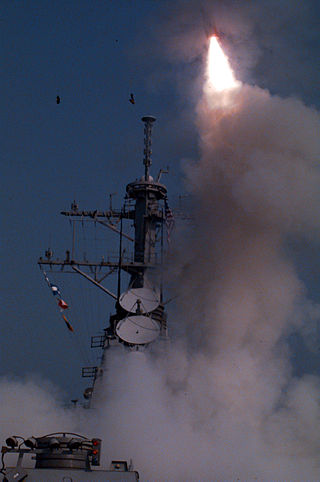
The 1996 cruise missile strikes on Iraq, codenamed Operation Desert Strike, were joint United States Navy–United States Air Force strikes conducted on 3 September against air defense targets in southern Iraq, in response to an Iraqi offensive in the Kurdish Civil War.

A dispute exists over the legitimacy of the 2003 invasion of Iraq. The debate centers around the question whether the invasion was an unprovoked assault on an independent country that may have breached international law, or if the United Nations Security Council authorized the invasion. Those arguing for its legitimacy often point to Congressional Joint Resolution 114 and UN Security Council resolutions, such as Resolution 1441 and Resolution 678. Those arguing against its legitimacy also cite some of the same sources, stating they do not actually permit war but instead lay out conditions that must be met before war can be declared. Furthermore, the Security Council may only authorise the use of force against an "aggressor" in the interests of preserving peace, whereas the 2003 invasion of Iraq was not provoked by any aggressive military action.
Operation Opera, also known as Operation Babylon, was a surprise airstrike conducted by the Israeli Air Force on 7 June 1981, which destroyed an unfinished Iraqi nuclear reactor located 17 kilometres southeast of Baghdad, Iraq. The Israeli operation came a year after the Islamic Republic of Iran Air Force had caused minor damage to the same nuclear facility in Operation Scorch Sword, with the damage having been subsequently repaired by French technicians. Operation Opera, and related Israeli government statements following it, established the Begin Doctrine, which explicitly stated the strike was not an anomaly, but instead "a precedent for every future government in Israel". Israel's counter-proliferation preventive strike added another dimension to its existing policy of deliberate ambiguity, as it related to the nuclear weapons capability of other states in the region.

The United Nations Monitoring, Verification and Inspection Commission (UNMOVIC) and the U.S.-led Iraq Survey Group (ISG) failed to find any of the alleged stockpiles of weapons of mass destruction in Iraq that were used as an impetus for the 2003 invasion. The United States effectively terminated the search effort for unconventional weaponry in 2005, and the Iraq Intelligence Commission concluded that the judgements of the U.S. intelligence community about the continued existence of weapons of mass destruction and an associated military program were wrong. The official findings by the CIA in 2004 were that Iraqi leader Saddam Hussein "did not possess stockpiles of illicit weapons at the time of the U.S. invasion in March 2003 and had not begun any program to produce them."

Operation Southern Watch was an air-centric military operation conducted by the United States Department of Defense from August 1992 to March 2003.
The cruise missiles strike on Iraq in June 1993 were ordered by U.S. President Bill Clinton as both a retaliation and a warning triggered by the attempted assassination by alleged Iraqi intelligence agents of former U.S. President George H. W. Bush while on a visit to Kuwait from 14–16 April 1993.
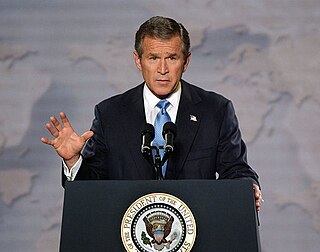
Prior to the Iraq War, the United States accused Iraq of developing weapons of mass destruction and having links with al-Qaeda. In 1991, the United Nations Security Council Resolution 687 was adopted and subsequent UN weapons inspectors were inside Iraq. This period also saw low-level hostilities between Iraq and the United States-led coalition from 1991–2003.

The Gulf War of 1990–1991 included an air campaign, as the air forces of the coalition carried out an extensive aerial bombing campaign from 17 January 1991 to 23 February 1991 against Iraq. Spearheaded by the United States, the coalition flew over 100,000 sorties, dropping 88,500 tons of bombs, widely destroying military and civilian infrastructure. The air campaign was commanded by United States Air Force (USAF) lieutenant general Chuck Horner, who briefly served as Commander-in-Chief—Forward of U.S. Central Command while general Norman Schwarzkopf was still in the United States. The British air commanders were Air Vice-Marshal Andrew Wilson and Air Vice-Marshal Bill Wratten. The air campaign had largely finished by 23 February 1991 when the coalition invasion of Kuwait took place.



